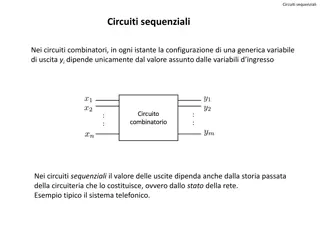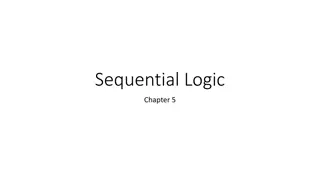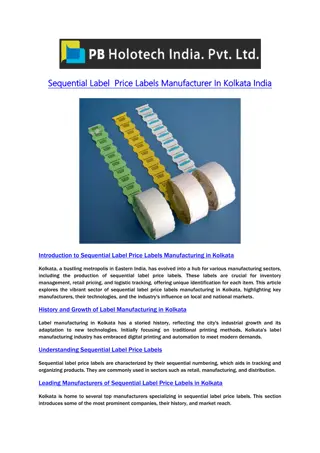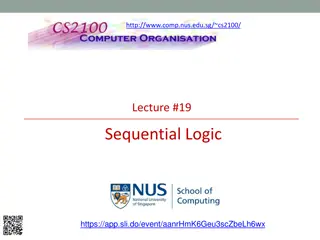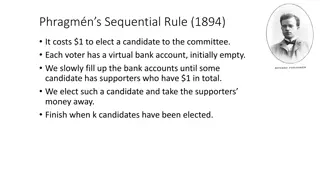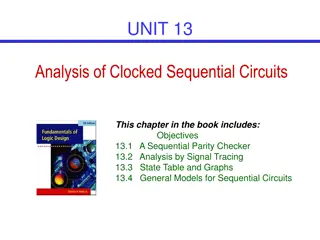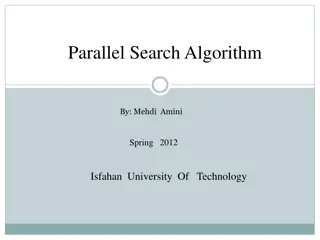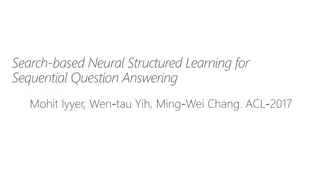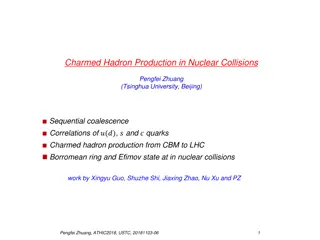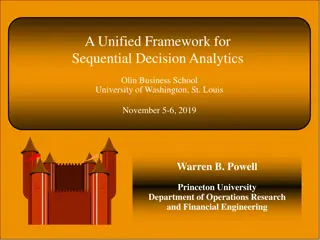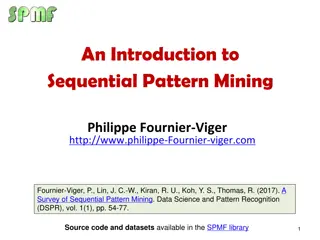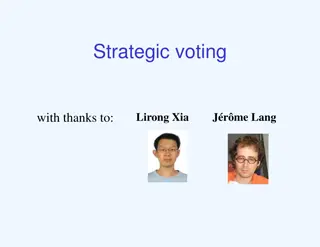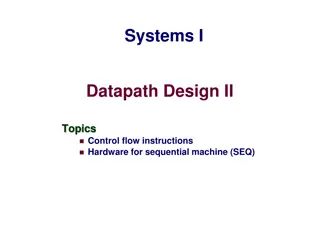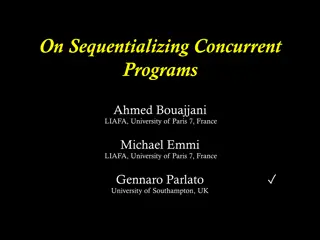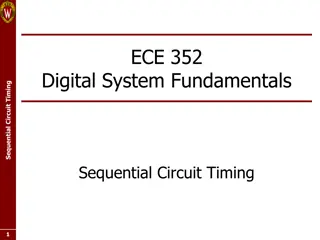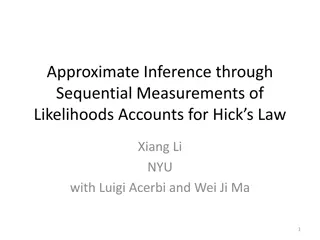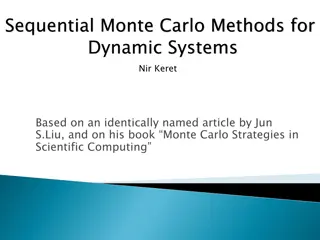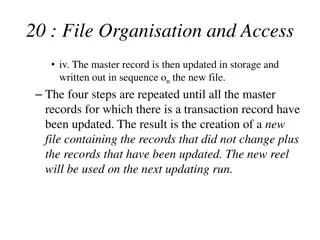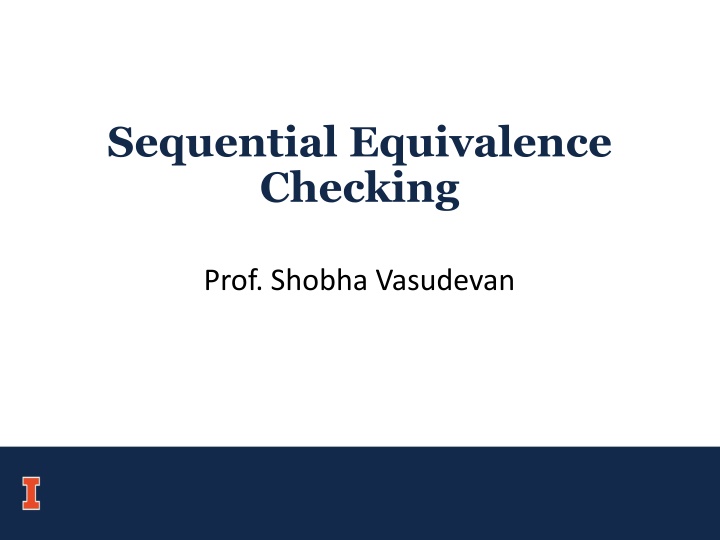
Sequential Circuits and Finite State Machines
Explore the concepts of sequential circuits, including the differences from combinational circuits, representing functionalities, FSM verification, and definitions in mathematical terms. Dive into examples to grasp the practical application of these concepts.
Download Presentation

Please find below an Image/Link to download the presentation.
The content on the website is provided AS IS for your information and personal use only. It may not be sold, licensed, or shared on other websites without obtaining consent from the author. If you encounter any issues during the download, it is possible that the publisher has removed the file from their server.
You are allowed to download the files provided on this website for personal or commercial use, subject to the condition that they are used lawfully. All files are the property of their respective owners.
The content on the website is provided AS IS for your information and personal use only. It may not be sold, licensed, or shared on other websites without obtaining consent from the author.
E N D
Presentation Transcript
Sequential Equivalence Checking Prof. Shobha Vasudevan
Sequential circuits What are sequential circuits? How are they different from combinational circuits? How do you describe/represent the functionality of sequential circuits?
FSM Verification: Reminders What s in an FSM? States: unique bit pattern represents each state; FFs store state External inputs: inputs from the outside world Next state logic: from current state and external inputs, this makes the inputs to the FFs that determine the next state at the next clock tick Output logic: from states (and maybe inputs) makes combinational FSM outputs Clock: synchronizes everything; only states changes on clock tick Next State Logic D Q Output Logic
Definitions In mathematical terms, a (completely specified, deterministic) Finite State Machine (FSM) of Mealy type is a 6-tuple I, S,?,S0,O,? where: I is the input alphabet i.e., a finite, non-empty set of input values; S is the (finite, non-empty) set of states; ? ?: ? ? ? ? ? ?is the next-state function; ? ?0 ? ?is the set of initial (reset) states; O is the output alphabet; ? ? : ? ? ? ? ? ?is the output function; How is this definition different for Moore machines?
Example state machine 0/0 0/0 D B 0/0 1/0 1/1 1/0 A F 1/1 1/1 0/0 1/0 C E 0/0 0/0
Example Give the tuple I, S,?,S0,O,? and draw the state diagram for the following Flow Table: Next State/Output Present State x = 0 x = 1 A (Start) B E/0 D/0 D/1 F/0 C E/0 B/1 D E B/0 C/0 F/0 F/1 F B/0 C/0
Example Answer: I = {0,1}; S = {A,B,C,D,E,F}; O = {0,1} ?(?,0)=?, ?(?,1)=?, ?(?,1)=?, ?(?,0)=?, ?(?,1)=?, S0 = {A} ?(?,0)=0, ?(?,1)=1, ?(?,0)=0, ?(?,1)=0, ?(?,0)=0, ?(?,1)=1, ?(?,0)=?, ?(?,0)=?, ?(?,1)=?, ?(?,1)=?, ?(?,0)=?, ?(?,0)=?, ?(?,1)=?; ?(?,0)=0, ?(?,1)=1, ?(?,1)=0, ?(?,0)=0, ?(?,0)=0, ?(?,1)=0;
Example 0/0 0/0 D B 0/0 1/0 1/1 1/0 A F 1/1 1/1 0/0 1/0 C E 0/0 0/0
Incomplete Specification An FSM is incompletely specified if the next-state function and/or the output functions are specified only for some combinations of inputs and present states.
Example I PS NS O 0 s1 s4 0 1 s1 s3 0 1/- s1 s2 0 s2 - - 0/1 1 s2 s1 - 0/1 0 s3 s1 1 0/0 1 s3 - 1 1/0 0 s4 s2 1 s3 s4 1/1 1 s4 s3 1 Is there any discrepancy between these representations?
FSM Verification: Whats the Problem? Several scenarios You have a trusted implementation of the machine that you know is correct (but maybe not optimal as hardware) and a real implementation as gates. Are they the same? You have an old implementation in one technology, and a new implementation in another technology (eg, a different tech library). Is old == new? Why is this hard? Because of what same means here Has to do with behavior over time -- this temporal dependence is new for us... We need to be more precise
Equivalent FSMs Means this: Start them in some known equivalent states; clock starts running For every possible combination of inputs over future clock ticks, two machines will have identical outputs (Doesn t say anything about logic delays or low level stuff like that; just think about ideal clock ticks here...) FSM 1 FSM 2 Next State Logic Logic Next State Logic Next State D Q D Q D Q Output Logic Output Logic Output Logic
FSM Equivalence: Easy Case Sometimes this isn t too hard: special case Suppose 2 FSMs have identical state encodings: same #bits, same unique bit pattern for each state, same kinds of FFs Then this reduces to combinational equiv. checking FSM 1 FSM 2 Next State Logic Next State Logic Next State Logic D Q D Q D Q Output Logic Output Logic Output Logic
FSM Equivalence: Hard Case FSMs not always so easy to check. More general case: 4 states. 2 state variables p,q. 1 input x. 1 output z. D FFs. Input PS NS x pq p+q+ 0 0 0 0 1 1 0 1 1 1 0 0 0 1 1 0 1 1 00 01 11 10 pq=01 State: pq=00 x=0 x=0 A/0 B/0 x=0,1 x=1 x=1 D/1 x=0,1 C/0 pq=11 pq=10 pq pq p 00 01 11 10 0 1 x x q 0 0 0 z 1 1 1 p+ (= D input on p FF) q+ (= D input on q FF)
FSM1 Implementation It looks like this... State Logic Next State Logic D Q D Q Output Logic
FSM2: Same Behavior, Different Implementation Let s implement it as a 1-hot machine Now, 4 state variables: abcd; again D FFs, but now 4 of them abcd=0100 State: abcd=1000 Can just read off the NS logic x=0 x=0 A/0 B/0 x=0,1 x=1 x=1 D/1 x=0,1 C/0 abcd = 0010 abcd=0001 1 hot example transition...
FSM 2 Implementation It looks like this State Logic Next State Logic D Q D Q D Q Output Logic D Q
FSM Equivalance Checking This is why it s hard Cannot just look at the logic now and state they are the same Need a whole new, systematic method that deals with temporal aspect of things here, and the possible differences in encodings FSM 2 Logic FSM 1 Logic Next State Logic p+ = pq + p x q+ = p q + p x p+ q+ p q a+ b+ c+ d+ a b c d Next State Logic a+ = d b+ = ax + bx c+ = ax + c d+ = bx x Output Logic z = pq z x Output Logic z = d z
FSM Formal Verification Strategy 4 Big Ideas Sets as Boolean functions Use BDDs to represent sets of things Symbolic representation of FSMs Represent them as sets of allowable transitions Reachability analysis Represents the sets of FSM states you can get to from the start state on 0 clock ticks, 1 clock tick, 2 ticks, etc. Cross-product FSMs Take 2 FSMs you want to compare for equivalence, and make 1 single new special machine, on which reachability analysis == verification
Distinguishing Sequences Definition: Consider two states s and t of a given FSM, and a k-string (sequence of input symbols) x = (x0,x1, ,xk-1). Suppose the string x produces one run Run_s = (s0,s1, ,sk-1), when starting from s0 (s=s0) and another run Run_t = (t0,t1, ,tk-1), when starting from t0 (t=t0). Further, let zs = (z0s,z1s, ,zk-1s) and zt = (z0t,z1t, ,zk-1t) be the corresponding output strings. The string x is said to be a length-k distinguishing sequence for states s and t if and only if: zk-1s zk-1t
Equivalent States Definition: Two states s and t are k-equivalent, written s k t, if and only if there does not exist a distinguishing sequence of length k or less for these states. Two states s and t are equivalent if and only if they are n- equivalent, where n = |S|. |S| is the cardinality of S, i.e. total number of states in S.
Equivalent States Theorem: s k+1t if and only if s k t and ? ?, ?? ???, where sx and tx are the x-successors of s and t. For this particular case, x can be the immediate next state of s or t
Equivalence Definition: We define the binary relation ??(?,?) ? ?as ??={(?,?) | ? ??)}. We also denote the ??equivalence classes of the relation ??by???, ?=1, ,??
Equivalence ?k is an equivalence relation Reflexive: A state is k-equivalent to itself Symmetric: s k t t k s Transitive: s kt, t k u s k u
Minimize this state machine 0/0 0/0 D B 0/0 1/0 1/1 1/0 A F 1/1 1/1 0/0 1/0 C E 0/0 0/0
Equivalence For Example: States in B11 = {A,C,E} are 1-equivalent States in B21 = {B,D,F} are also 1-equivalent A and B are 1-distinguishable A,C,E also 2-equivalent Is one equivalent Their successors under input 0 (E,E,C) are 1- equivalent Their successors under input 1 (D,B,F) are also 1-equivalent F not 2-equivalent to B Input 1: F goes to C, B goes to D C and D are not 1-equivalent {A,C} and {B,D} are fully equivalent Next State/Output Present State x = 0 x = 1 A E/0 D/1 (Start) B D/0 F/0 C E/0 B/1 D B/0 F/0 E C/0 F/1 F B/0 C/0
Partition-Refinement Goal: Determine the set of all equivalent state pairs of a given FSM. Phase 1: 1. Initialize P0 and P1 as partitions with one block containing all S states Gather a vector ox of the x outputs in each state sj Use ox to partition the vector into blocks with the same output value, Px1 Refine P1 0;?1 0= ?;?1= ?0 ?0= ?1 ??? ? ? { ??? ?? ? ?? ??1= ????????? ??,? ?1= ?????? ?1,??1 } 2. ?= ?(??,?) 3. 4.
Refinement Definition: If Pa = {Bia}, and Pb = {Bjb}, then Pa Pb, called the meet, or intersection, of partitions Pa, and Pb, is given by: Pa Pb = ij(Bia Bjb) the meet Pc of two partitions Pa and Pb is a refinement of both Pa and Pb.
Partition-Refinement Example (Phase 1): 1. Initial partition P1 = P0 = {B1}, where B1 = {A,B,C,D,E,F}. 2. First for loop: x = 0: o0 = (0,0,0,0,0,0), s = (A,B,C,D,E,F), PARTITION returns P01 = {S}, P1 = P1 P01 = {S} x = 1: o0 = (1,0,1,0,1,0), s = (A,B,C,D,E,F), PARTITION returns P11 = {B1x, B2x}, where B1x = {A,C,E} and B2x = {B,D,F}. P1 = P1 P11 = {{A,C,E},{B,D,F}}
Partition-Refinement Phase 2: 1. On each pass through the loop over k, we initialize Pk to the empty partition. 2. Loop through the blocks Bi of Pk-1 and compute Pik as a partition of Bi. a. Gather a vector of the x- successors of the states in Bi. b. Compute the corresponding vector of partition block indices (in partition Pk-1). c. Partition Bi into blocks with like block indices d. Refine the result with the current Pik. ??? ? = 2, , ? { ??= {} ??? ?? ?? 1{ ?? ??? ? ? { ?= ?? ?= ?(??,?) ??? ?? ?? ?? ??= ?????_????? ??,?? 1 ??? ?? ?= ????????? ??,? ?= ?????? ?? ?,??? ? } ??= ?? ?? ? } ?? ??= ?? 1 ?????? ??,? }
Partition-Refinement Example (Phase 2): First Pass (k = 2) (block B,D,F) 1. 2. 3. (block A,C,E) No refinement P2 = {{B,D},{F},{A,C,E}} x = 0: s = (B,D,F), t0 = (D,B,B), b0 = (1,1,1), Pb10 = {Bi} = {{B,D,F}}. x = 1: s = (B,D,F), t1 = (F,F,C), b1 = (1,1,2), Pb11 = {{B,D},{F}}. Set union: P2 = {{B,D},{F}}
Partition-Refinement Algorithm ?????_??????????? ?,?,?,? : / ????????? ?????????? ??????? ? ??? ??????????? ????? ??????????? / ?0= ?1 ??? ?? ? { ??? ?? ? ?? ??1= ????????? ??,? ?1= ?????? ?1,??1 } ?? ?1= ?0 ?????? ?0,0 ??? ? = 2, , ? { ??= {} ??? ?? ?? 1{ ?? ??? ? ? { ??? ?? ?? ?? ??= ?????_????? ??,?? 1 ??? ?? } ??= ?? ?? } ?? ??= ?? 1 ?????? ??,? } 0;?1 0= ?;?1= ?0 ?= ?(??,?) Sort and group by like outputs Phase 1 Return: all states are 1-equivalent Distinguishing path lengths Initialize Pk ?= ?? Initialize refined block partition ?= ?(??,?) ?= ????????? ??,? ?= ?????? ?? Phase 2 ?,??? ? Sort and group by like block indices ?
Cross Product Machine Given 2 FSMs to check... Just FSM1, FSM2, with FSM2 s states given new names (A , B , etc)... pq=01 State: pq=00 abcd=0100 State: abcd=1000 x=0 x=0 x=0 x=0 /0 A/0 /0 B/0 x=0,1 x=1 x=0,1 x=1 x=1 x=1 /0 D/1 /1 x=0,1 C/0 x=0,1 pq=11 pq=10 abcd = 0010 abcd=0001
Cross Product Machine: FSM1 FSM2 What are the states in FSM1 FSM2? ( == cross ) All pairs of possible states (FSM1 state, FSM2 state) pq=01 State: pq=00 abcd=0100 State: abcd=1000 x=0 x=0 x=0 x=0 /0 A/0 /0 B/0 x=0,1 x=1 x=0,1 x=1 x=1 x=1 /0 D/1 /1 x=0,1 C/0 x=0,1 pq=11 pq=10 abcd = 0010 abcd=0001 FSM1 FSM2 has 4*4=16 states
Cross Product Machine: FSM1 FSM2 What are the state variables for FSM1 FSM2 Easy, just all the state variables from FSM1 and from FSM2 State Logic Next State Logic p D Q q D Q ??? a D Q b D Q Output Logic ??? c D Q d D Q
Cross Product Machine: FSM1 FSM2 So, what then is the next-state logic for FSM1 FSM2? Easy again: just the 2 separate next-state blocks from FSM1, FSM2 State Logic Next State Logic p D Q FSM1 Next State Logic q D Q FSM2 Next State Logic a D Q b D Q c D Q Output Logic d ??? D Q
Cross Product Machine: FSM1 FSM2 So, what is the output logic for FSM1 FSM2 Now, it s different. The cross-product machine is really (up to now) just the 2 separate machines FSM1 and FSM2 running side-by-side We want to know: if we start them both in the same equivalent state, will we ever reach a combined state (FSM1 state vars, FSM2 state vars) where the outputs of the 2 machines are different FSM1 outputs FSM 1 inputs Should always be == 1 if FSM1 = FSM2 == ? FSM 2 FSM2 outputs clock
Cross Product Machine: FSM1 FSM2 So, what is the output logic for FSM1 FSM2? State Logic Next State Logic p D Q FSM1 Next State Logic q D Q FSM2 Next State Logic a D Q Output Logic b D Q FSM1 Output Logic c D Q =? FSM2 Output Logic d D Q
Cross Product Machine Reachability Analysis Where are we? We can build, mechanically, the cross product machine What good is this? FSM1 and FSM2 are equivalent if, when started in the same initial equivalent states, it is never possible to reach a state where the output of the cross product machine == 0 Put another way: output of cross product machine should always be ==1, for any combined state (FSM1 state, FSM2 state) we can reach from (FSM1 start, FSM2 start) How do we do this? We already know how...
Cross Product Reachability Analysis Build the cross product machine Means build the next state logic, and the output logic for it Do reachability analysis on [ FSM1 FSM2 ] In our little example, start with A=00, = 1000 states: R0(p+,q+,a+,b+,c+,d+) = (p+ )(q+ )( a+)(b+ )(c+ ){d+ ) Build R1, R2, ... RK until it stops changing Now, you know pairs of states it is possible to reach from (A, ) start state...
Cross Product Reachability Analysis What does this tell you? Pairs of states you can get to from (A, ) Example abcd=0100 State: abcd=1000 pq=01 State: pq=00 x=0 x=0 x=0 x=0 /0 /0 A/0 B/0 x=0,1 x=0,1 x=1 x=1 x=1 x=1 /0 /1 D/1 x=0,1 x=0,1 C/0 pq=11 abcd = 0010 abcd=0001 pq=10 Example: 2 ticks, A B D Example: 2 ticks, So, in R0 we have (A, ), and in R2 we will have...
Verification via Reachability OK, we can build Rk for this FSM1 FSM2 Now what? Want to know if we can reach a combined state where cross-product output ==0; consider this logic... p+ q+ ==1 if (p+ q+, a+ b+ c+ d+) is a reachable pair final a+ b+ c+ d+ Rk Output Logic FSM1 Output Logic =? ==1 if output from p+ q+ same as output from a+ b+ c+ d+ FSM2 Output Logic
Verification via Reachability p+ q+ ==1 if (p+ q+, a+ b+ c+ d+) is a reachable pair final a+ b+ c+ d+ Rk Output Logic FSM1 Output Logic =? ==1 if output from p+ q+ same as output from a+ b+ c+ d+ FSM2 Output Logic Look what happens Build a BDD for this ckt; it has 6 inputs p+ q+ a+ b+ c+ d+, has 1 output If the 2 FSMs are equivalent, then this output == constant 0 BDD If these 2 FSMs NOT equivalent, this is some BDD with a 1 node in it All we have to do is see if this BDD != constant 0 BDD, and we are done!
Verification via Reachability What did we do here? We turned the complex temporal problem of verification of equivalence for all inputs over all subsequent clock ticks... ...into a series of BDD exercises, ending in a satisfiability check on a single (big, nasty) BDD; if any pattern of inputs makes this BDD ==1, then machines not equivalent Amazingly useful result Doable mechanically with a good BDD package Definitely NOT something you want to try to do by hand. On the HW, you get to do it for a similar pair of machines using the KBDD package to do the nasty Boolean manipulations


